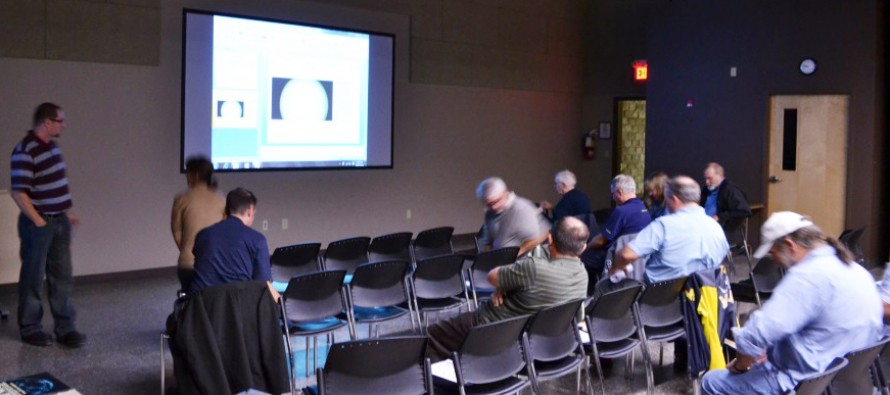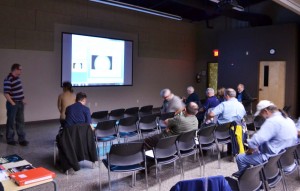Windsor astronomers share the night skies


Astronomers gather at 7:30 p.m. for the monthly meeting of the Royal Astronomical Society of Canada – Windsor Centre held at Ojibway Park Nature Centre located at 5200 Matchette Road in Windsor, Oct. 15. (ANDREW BRADLEY / The Converged Citizen)
By Andrew Bradley
Local astronomers are inviting the public to view the stars at their observatories.
Windsor’s 91-member chapter of the Royal Astronomical Society of Canada is one of 12 in Ontario. The organization has grown from its beginnings in Toronto 145 years ago to include 29 centres across Canada and nearly 4,000 members. With a mandate to encourage public interest and research, members of the Windsor centre meet on the third Tuesday of each month from September to June. The meetings, held at Ojibway Park Nature Centre are open to the public.
The society’s last two events, Point Pelee Dark Sky Night Oct. 5 and the Hallam Observatory Open House Oct. 12, were cancelled due to unfavourable weather.
“Numerous people did show up. They often do during the open houses,” said Matt McCall, incoming director of public education, who joined RASC in 2009. “Thankfully what we can do is show them astro-photography slideshows on our projector screen. So even when it’s cloudy and we can’t use the telescopes we can still show photographs that members have taken.”
Annual membership fees are $71 for adults and $41 for those under 21 and students under 25. Throughout the year members receive an observer’s handbook which lists eclipses, sunrise and sunset times, planetary positions and upcoming celestial events. They also receive subscriptions to three astronomy publications: Aurora, SkyNews and The Journal, each issued six times a year. Members may also use RASC observatories, telescopes and library.
Members are encouraged to make presentations at meetings. On Oct. 15 Windsor resident David Panton, a retired engineer, gave a slideshow explaining his homemade infrared light detector. With help from his brother Stan, it took Panton a year to build. Stars emitting only infrared light are invisible to the naked eye, but can be seen with detectors which have become useful tools for mapping the cosmos. Panton has installed his device at the Hallam Observatory located on South Middle Road near Comber, Ont. giving astronomers sight beyond sight.
“There are a lot of people in astronomy with billions of dollars to spend in the last hundred years,” said Panton. “There’s no way you can compete with them. But one of the things that you can learn from doing a project like this is that you get a lot of appreciation for guys that build the satellites and spacecraft that measure these things.”
On Oct. 18 Hallam’s telescope was trained on a bright visible star, Alpheratz, in the Pegasus Constellation that is 97 light years from Earth. Children and their parents from the Montessori Academy of Windsor were invited for the viewing.
“When I was five years old my parents took me outside with an atlas from the 1960s and it had two big pages with drawings of the solar system,” said McCall. “It probably would have been about 1991 and I think all five of the major planets were visible in the sky at one time right after sunset – and that’s what really sparked my interest.”
Following their look at Alpheratz, RASC members are hoping a few more youngsters find their inspiration looking to the stars.


